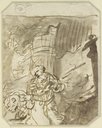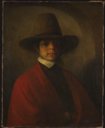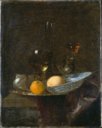Back to top
Rembrandt Harmensz. van Rijn
Painter, Etcher, Commercial artist (male), Draughtsman, Art collector (male) and Art dealer (male)
- Born
- 1606 in Leiden
- Died
- ca. 1669 in Amsterdam
- School
- Baroque
35 Works by Rembrandt Harmensz. van Rijn
- David Playing the Harp in front of Saul
![David Playing the Harp in front of Saul, Rembrandt Harmensz. van Rijn]()
- Portrait of Maertgen van Bilderbeecq
![Portrait of Maertgen van Bilderbeecq, Rembrandt Harmensz. van Rijn]()
- The Blinding of Samson
![The Blinding of Samson, Rembrandt Harmensz. van Rijn]()
- Bauernhaus, davor ein Baum und eine sich bückende Figur
![Bauernhaus, davor ein Baum und eine sich bückende Figur, Rembrandt Harmensz. van Rijn; school]()
- Der Levite mit dem Mann aus Gibeah
![Der Levite mit dem Mann aus Gibeah, Rembrandt Harmensz. van Rijn; school]()
- Ein Mann schreitet eine Treppe hinauf
![Ein Mann schreitet eine Treppe hinauf, Rembrandt Harmensz. van Rijn; circle]()
- Fantasielandschaft mit hohem Felsengebirge
![Fantasielandschaft mit hohem Felsengebirge, Rembrandt Harmensz. van Rijn; ?]()
- Halbfigur einer im Profil nach rechts sitzenden jungen Frau, die in einem Buch liest
![Halbfigur einer im Profil nach rechts sitzenden jungen Frau, die in einem Buch liest, Rembrandt Harmensz. van Rijn; school]()
- Heiliger Hieronymus im Gebet
![Heiliger Hieronymus im Gebet, Rembrandt Harmensz. van Rijn; ?]()
- Kalvarienberg
![Kalvarienberg, Rembrandt Harmensz. van Rijn; school]()
- Petrus im Gefängnis, vom Engel geweckt
![Petrus im Gefängnis, vom Engel geweckt, Rembrandt Harmensz. van Rijn; school]()
- Ruben at the well
![Ruben at the well, Rembrandt Harmensz. van Rijn]()
- Satan tempting Christ, to change stones into braed
![Satan tempting Christ, to change stones into braed, Rembrandt Harmensz. van Rijn; ?]()
- Saul und die Hexe von Endor
![Saul und die Hexe von Endor, Rembrandt Harmensz. van Rijn; school]()
- Schauspieler mit hoher Kappe
![Schauspieler mit hoher Kappe, Rembrandt Harmensz. van Rijn]()
- Sitting woman
![Sitting woman, Rembrandt Harmensz. van Rijn; school]()
- The liberation of Peter
![The liberation of Peter, Rembrandt Harmensz. van Rijn; school]()
- Two butchers
![Two butchers, Rembrandt Harmensz. van Rijn]()
- Two men talking
![Two men talking, Rembrandt Harmensz. van Rijn; school]()
- Vor einer nur angedeuteten Gestalt kniender Mann
![Vor einer nur angedeuteten Gestalt kniender Mann, Rembrandt Harmensz. van Rijn; ?]()
- Well in front of a hut
![Well in front of a hut, Rembrandt Harmensz. van Rijn; school]()
- Adam and Eve
![Adam and Eve, Rembrandt Harmensz. van Rijn]()
- Canal with a large boat and a Bridge
![Canal with a large boat and a Bridge, Rembrandt Harmensz. van Rijn, after Rembrandt Harmensz. van Rijn]()
- Christ crucified between the two thieves: 'The three crosses'
![Christ crucified between the two thieves: 'The three crosses', Rembrandt Harmensz. van Rijn]()
- Christ crucified between the two thieves: 'The three crosses'
![Christ crucified between the two thieves: 'The three crosses', Rembrandt Harmensz. van Rijn]()
- Jan Six' bridge
![Jan Six' bridge, Rembrandt Harmensz. van Rijn]()
- Old Man Seated (The Drunken Lot?)
![Old Man Seated (The Drunken Lot?), Rembrandt Harmensz. van Rijn]()
- Self-Portrait etching at a window
![Self-Portrait etching at a window, Rembrandt Harmensz. van Rijn]()
- Self-Portrait in a cap, wide-eyed and open-mouthed
![Self-Portrait in a cap, wide-eyed and open-mouthed, Rembrandt Harmensz. van Rijn]()
- Self-Portrait leaning on a stone sill
![Self-Portrait leaning on a stone sill, Rembrandt Harmensz. van Rijn]()
- Show all
2 Works based on Rembrandt Harmensz. van Rijn
Works displaying Rembrandt Harmensz. van Rijn
Biography
Persons connected to Rembrandt Harmensz. van Rijn
- Stoffels, Hendrickje Life companion (female)
- Lastman, Pieter Pietersz. Teacher (male)
- Swanenburg, Jacob Isaacsz. van Teacher (male)
- Bol, Ferdinand Pupil (male)
- Dijck, Abraham van Pupil (male)
- Doomer, Lambert Pupil (male)
- Dou, Gerrit Pupil (male)
- Drost, Willem Pupil (male)
- Eeckhout, Gerbrand van den Pupil (male)
- Flinck, Govaert Pupil (male)
- Furnerius, Abraham Pupil (male)
- Gelder, Arent de Pupil (male)
- Hoogstraten, Samuel van Pupil (male)
- Levecq, Jacob Pupil (male)
- Maes, Nicolaes Pupil (male)
- Mayr, Johann Ulrich Pupil (male)
- Victors, Jan Pupil (male)
- Vliet, Jan Joris van der Pupil (male)
- Fabritius, Carel Workshop employee
- Cappelle, Jan van de Art collector (male)
- Callot, Jacques Artist
- Jonghe, Clement de Friend (male)
- Roghman, Roelant Friend (male)
- Six, Jan Friend (male)
Works associated with Rembrandt Harmensz. van Rijn
- Giovanni Domenico TiepoloHead of an Old Man
![Head of an Old Man, Giovanni Domenico Tiepolo]()
- Jan Miense MolenaerMan Smoking and Holding an Empty Wine Glass
![Man Smoking and Holding an Empty Wine Glass, Jan Miense Molenaer]()
- Jan SteenMoses Striking the Rock
![Moses Striking the Rock, Jan Steen]()
- Frans HalsPortrait of a Man
![Portrait of a Man, Frans Hals]()
- Frans HalsPortrait of a Woman
![Portrait of a Woman, Frans Hals]()
- Nicolaes MaesPortrait of a Woman Wearing a Black Dress
![Portrait of a Woman Wearing a Black Dress, Nicolaes Maes]()
- Frans van Mieris the ElderPortrait of a Woman with a Cap
![Portrait of a Woman with a Cap, Frans van Mieris the Elder]()
- Ferdinand BolPortrait of a Young Man
![Portrait of a Young Man, Ferdinand Bol]()
- Godfried SchalckenPortrait of an Artist in His Studio
![Portrait of an Artist in His Studio, Godfried Schalcken]()
- Caspar NetscherPortrait of Pieter Six with a Servant Bearing Hunting Booty
![Portrait of Pieter Six with a Servant Bearing Hunting Booty, Caspar Netscher]()
- Barent FabritiusSelf-Portrait
![Self-Portrait, Barent Fabritius]()
- Arent de GelderSelf-Portrait as Zeuxis Portraying an Ugly Old Woman
![Self-Portrait as Zeuxis Portraying an Ugly Old Woman, Arent de Gelder]()
- David Teniers the YoungerSmoker at an Inn
![Smoker at an Inn, David Teniers the Younger]()
- Willem Kalf; successionStill Life with Oranges
![Still Life with Oranges, Willem Kalf; succession]()
- Januarius ZickThe Adoration of the Shepherds
![The Adoration of the Shepherds, Januarius Zick]()
- Barent FabritiusThe Birth and Naming of St John the Baptist
![The Birth and Naming of St John the Baptist, Barent Fabritius]()
- Adriaen BrouwerThe Foot Operation
![The Foot Operation, Adriaen Brouwer]()
- Januarius ZickThe Presentation in the Temple
![The Presentation in the Temple, Januarius Zick]()
- Johann Georg TrautmannThe Raising of Lazarus
![The Raising of Lazarus, Johann Georg Trautmann]()
- Johann Georg TrautmannThe Transfiguration
![The Transfiguration, Johann Georg Trautmann]()
- Johann Ulrich MayrWoman Holding a Basket of Fruits
![Woman Holding a Basket of Fruits, Johann Ulrich Mayr]()
- Lambert DoomerView of Cowes Harbour, Isle of Wight
![View of Cowes Harbour, Isle of Wight, Lambert Doomer]()
- Arie de VoisHead of a Bearded Man in Oriental Costume
![Head of a Bearded Man in Oriental Costume, Arie de Vois]()






















































